Sabudana Thalipeeth is a crispy, flavorful flatbread from Maharashtra, made with sabudana (tapioca pearls), potatoes, peanuts, fresh coriander, and flavored with ginger, green chilies, and cumin. Often enjoyed during fasting (vrat/upvas), it’s simple, filling, and served with yogurt or chutney. Learn how to make it with tips for shaping and cooking to help you make perfect thalipeeth every time. Here's how to make it with step-by-step photos and video.
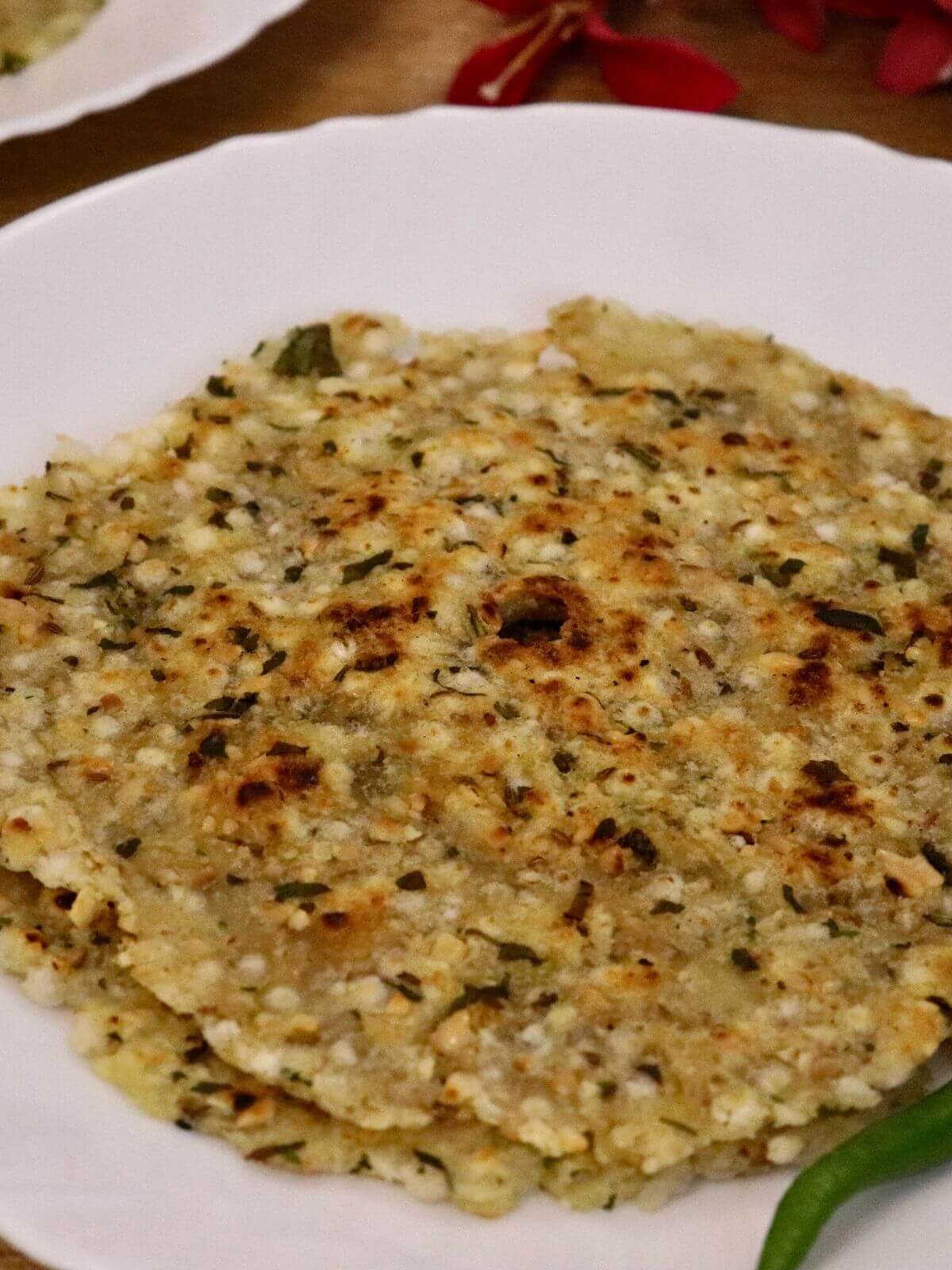
Jump to:
Sabudana thalipeeth is a tasty Indian pancake, crispy on the outside and soft chewy inside. It is also known as "Upvasache Thalipeeth" in the Marathi language as it is made mostly during Hindu fasting seasons like Shravan, Sankasti, and Navratri just like sabudana khichdi and sabudana vada.
My first try at sabudana thalipeeth? Total disaster. The thalipeeth dough was sticky and shaping them was a real struggle. But after making it many times, I've realized it's super easy.
The secret to a perfect thalipeeth is knowing some tips and tricks. So, here's my recipe, with all the secrets I've learned, to help you make perfect sabudana thalipeeth at home. Let me tell you these soft yet crispy pancakes are so filling and satisfying, making them a perfect choice for breakfast or a snack.
Ingredients Notes
This sabudana thalipeeth recipe for fasting uses the same ingredients that are used in making sabudana khichdi and sabudana vada. The ingredients used in this sabudana recipe are simple and easily available in your kitchen pantry. Here’s what you will need to make this thalipeeth recipe.
- Sabudana: Also known as tapioca pearls or sago. They are available in different sizes. Use medium-sized sabudana for this sabudana recipe.
- Peanuts (Shengdana/Mungfali): Adds a crunch and flavor to the thalipeeth recipe.
- Potato: It helps to bind the thalipeeth dough. Cook potatoes, peel them, and grate them. Substitute with sweet potatoes.
- Green chilies & ginger: They add flavor to the thalipeeth. If you do not like spicy or making them for kids avoid adding green chilies. Substitute green chilies with red chili powder or paprika.
- Cumin: It adds a nice flavor and aids in digestion.
- Salt: If you are making thalipeeth recipe for fasting use sendha namak.
- Herbs: Coriander leaves and curry leaves add fresh flavor to this sabudana recipe. You can skip curry leaves if not available.
For the detailed list of ingredients & their measurements, please check out the recipe card below.
How to make Sabudana Thalipeeth Recipe
Soaking sabudana
1) Rinse the sabudana two or three times until the water runs clear. Drain it, then add one cup of water. Cover and soak the sabudana overnight or for 4-6 hours. By morning, all the water should be absorbed. Mash one sabudana to check if it gets mashed easily. Set the soaked sabudana aside.
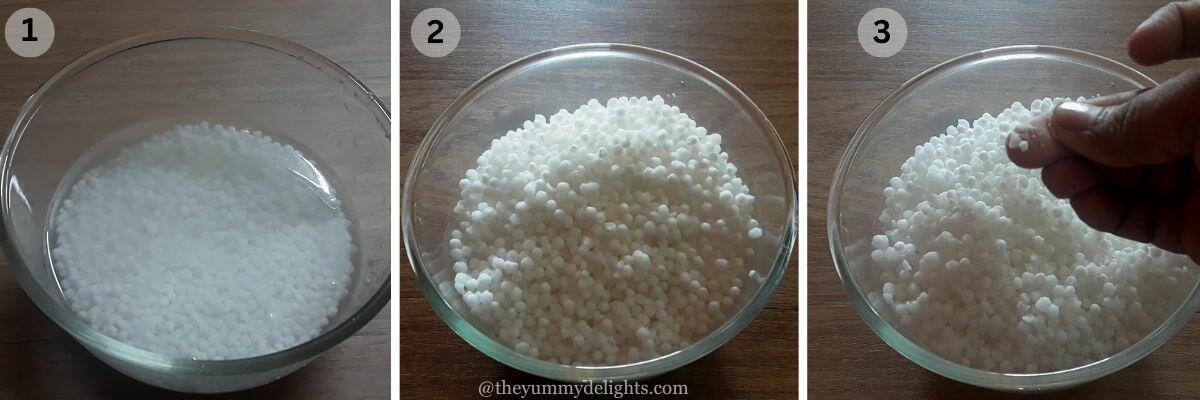
2) Dry-roast the peanuts in a pan over low to medium heat, stirring constantly until golden brown spots appear. Remove from the heat and let them cool to room temperature. Rub the peanuts between your palms to remove the skin. Coarsely grind the roasted peanuts using a chopper or a mortar and pestle.
Tip: Do not grind them too coarsely. They should be finely ground, but not powdered. If there are large chunks of peanuts, it will be difficult to shape or fry the thalipeeth as it will break and not hold its shape.
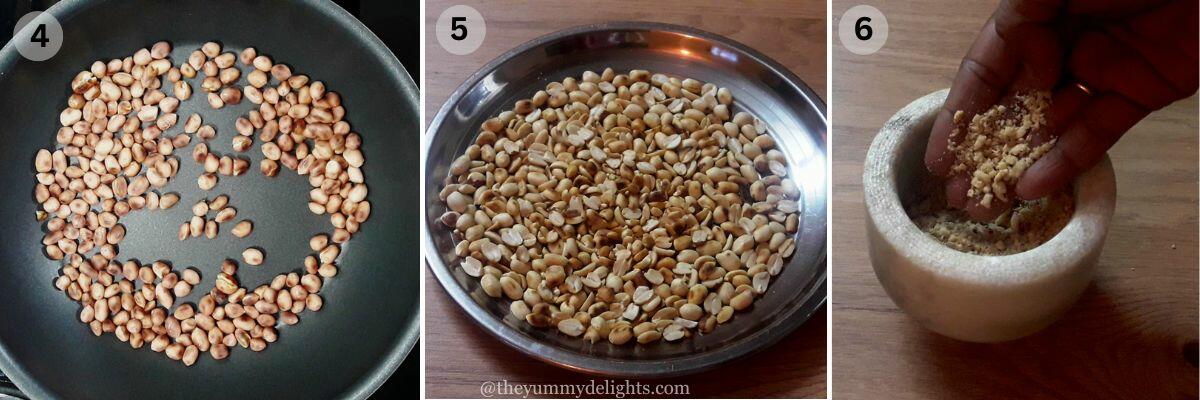
Making sabudana thalipeeth dough
3) In a mixing bowl, add the soaked sabudana, potatoes, chopped peanuts, green chilies, ginger, cumin, salt, coriander leaves, and curry leaves. Mix well while mashing them slightly until the mixture holds its shape.
Tip: Apply oil on your palms before you handle the dough mixture.
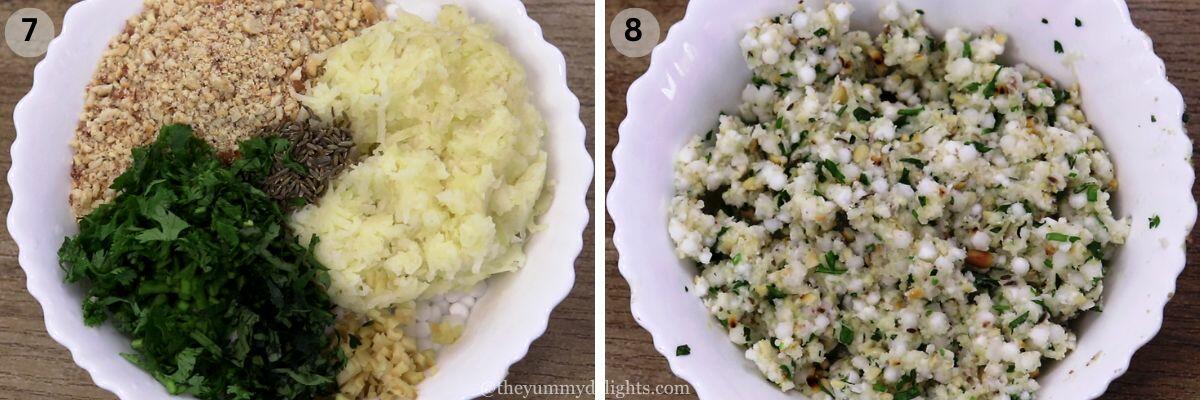
Shaping the thalipeeth
4) Lightly oil a piece of parchment paper or butter paper. Take a portion of the sabudana mixture, and place it on the parchment paper. Wet your fingers with water and gently pat the mixture to spread it. To prevent the sides from tearing, hold them with your other hand while spreading (image 11). Shape the dough into a round disc, similar to a roti (Indian flatbread). Finally, make a small hole in the center. Watch the video for easy understanding.
Tip: Using wet fingers prevents the dough from sticking while spreading and shaping thalipeeth.
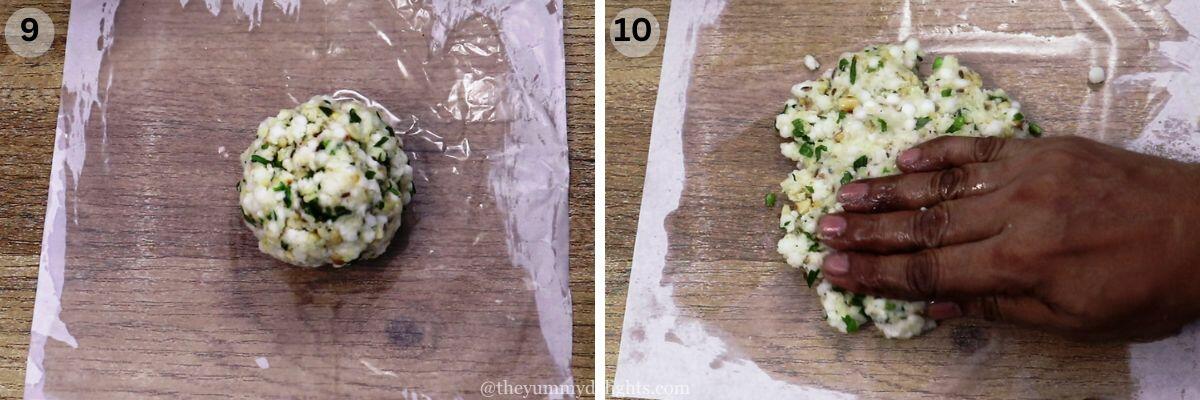
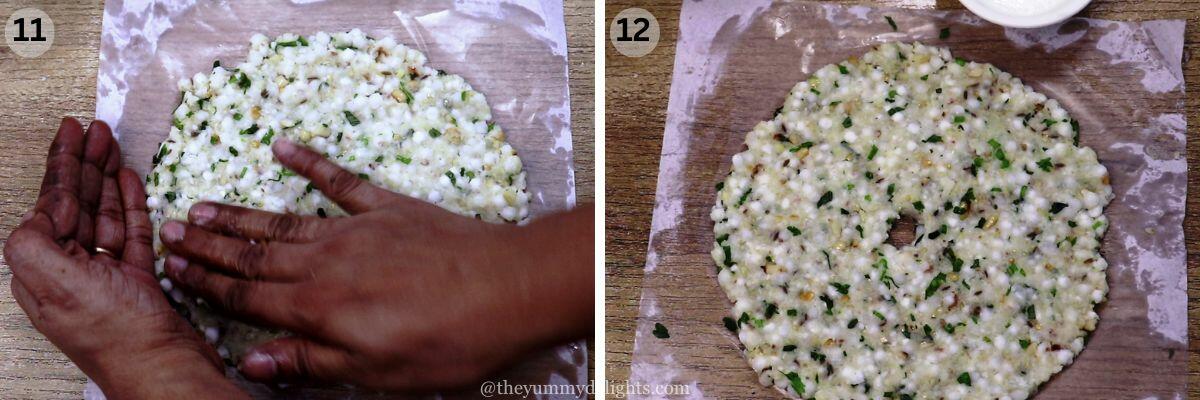
5) An easier way to shape thalipeeth is to use a plate. Place parchment paper on the plate, and spread the dough with wet fingers. This makes it much simpler to rotate and shape the thalipeeth, ensuring they are all the same size.
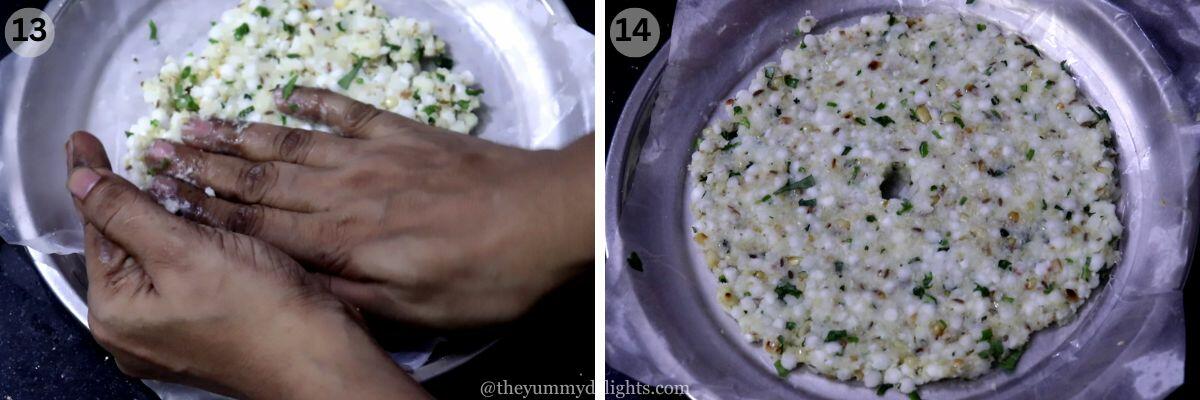
Cooking sabudana thalipeeth
6) Heat a tawa (griddle) over medium-low heat. Once the skillet is hot, place the thalipeeth onto it, with the parchment paper facing upwards. Reduce the heat to low-medium and cook for a minute. Gently peel off the parchment paper.
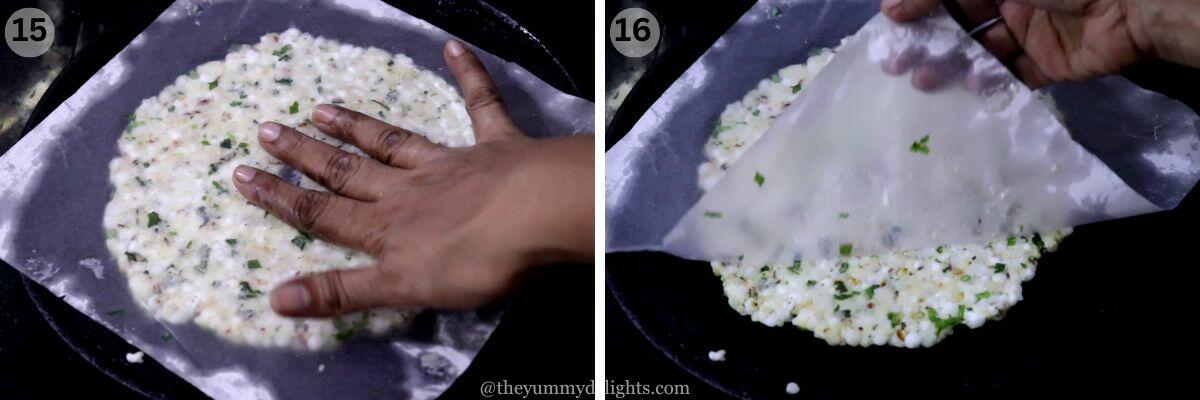
7) Drizzle one teaspoon of oil over the top and center of the thalipeeth. Cook until golden brown spots appear. Meanwhile, you can shape another thalipeeth. Flip and cook the other side until golden and crispy. Remove sabudana thalipeeth to a plate. Serve with chutney or yogurt.
Tip: Cook it on low heat until golden brown spots appear, then flip it. Don't flip it too early, or it will break. Also never cook thalipeeth on high heat. Add more oil if needed.
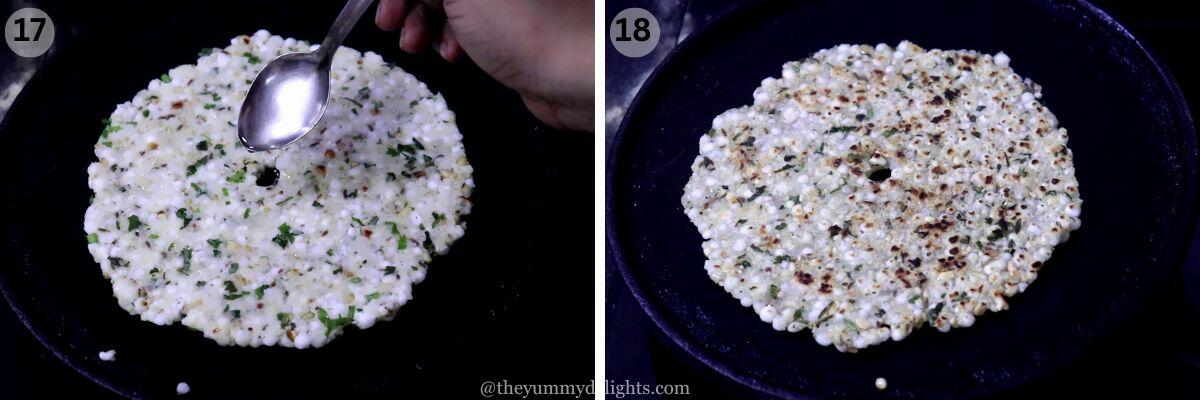
Tips to make Best Sabudana Thalipeeth
- Soaking sabudana: Make sure the soaked sabudana is soft and separate. If it feels hard, sprinkle some water over it, cover and keep it aside for 30 minutes to an hour.
- Binding the dough: Make sure the potatoes are cooked perfectly. Boil potatoes until fork-tender but not mushy. Cool boiled potatoes before grating. Overcooked potatoes may make the thalipeeth mixture soggy and sticky. Also, grate the cooked potatoes before adding them to the thalipeeth mixture.
- Cooking thalipeeth: Always cook on medium to low heat for even cooking and crispy edges. High heat will result in soft thalipeeth that are difficult to flip and break easily.
- Flipping the thalipeeth carefully: Wait until the bottom side of the thalipeeth is golden brown before flipping to prevent the thalipeeth from breaking.
Frequently Asked Questions
There are several reasons like
1) Thalipeeth dough mixture is dry: The thalipeeth dough needs proper moisture. Add more mashed potato or a little water to bind it.
2) Sabudana didn’t soak well: If the sabudana isn't soaked enough, it won't bind well. Mash one sabudana between your thumb and index finger to check whether it is soft and mashes easily. If it is hard sprinkle some water and keep it covered aside for a few minutes. Ensure the sabudana is fully softened before using.
3) Dough being too loose: If the dough is too loose due to excess moisture from the sabudana or potatoes, add a little flour, such as singhada or rajgeera, to help bind it.
4) Cooking on high heat: It will make sabudana thalipeeth soft and when you flip, it will break. So cook on low-medium heat until golden brown and then flip it.
Yes, you can replace potatoes with sweet potatoes for binding.
It’s best to use it fresh, but you can refrigerate the mixture for 4-6 hours. Transfer it to an airtight container and refrigerate.
Cook thalipeeth on medium-low heat until golden brown spots appear on them to ensure even cooking. Use enough ghee or oil to crisp the edges. Don't flip the thalipeeth until golden spots appear on them.
Other fasting recipes you may like
- Sabudana Khichdi
- Crispy Sabudana Vada
- Sama Ke Chawal (Sama Rice Pulao)
- Bharwa Bhindi (No Onion, No Garlic)
- Dum Aloo (No Onion, No Garlic)
If you try this recipe, please leave a comment and rating below. We'd love to hear your feedback.
And, consider following me on social media so we can stay connected. I’m on Facebook, Pinterest, and YouTube!
Recipe Card
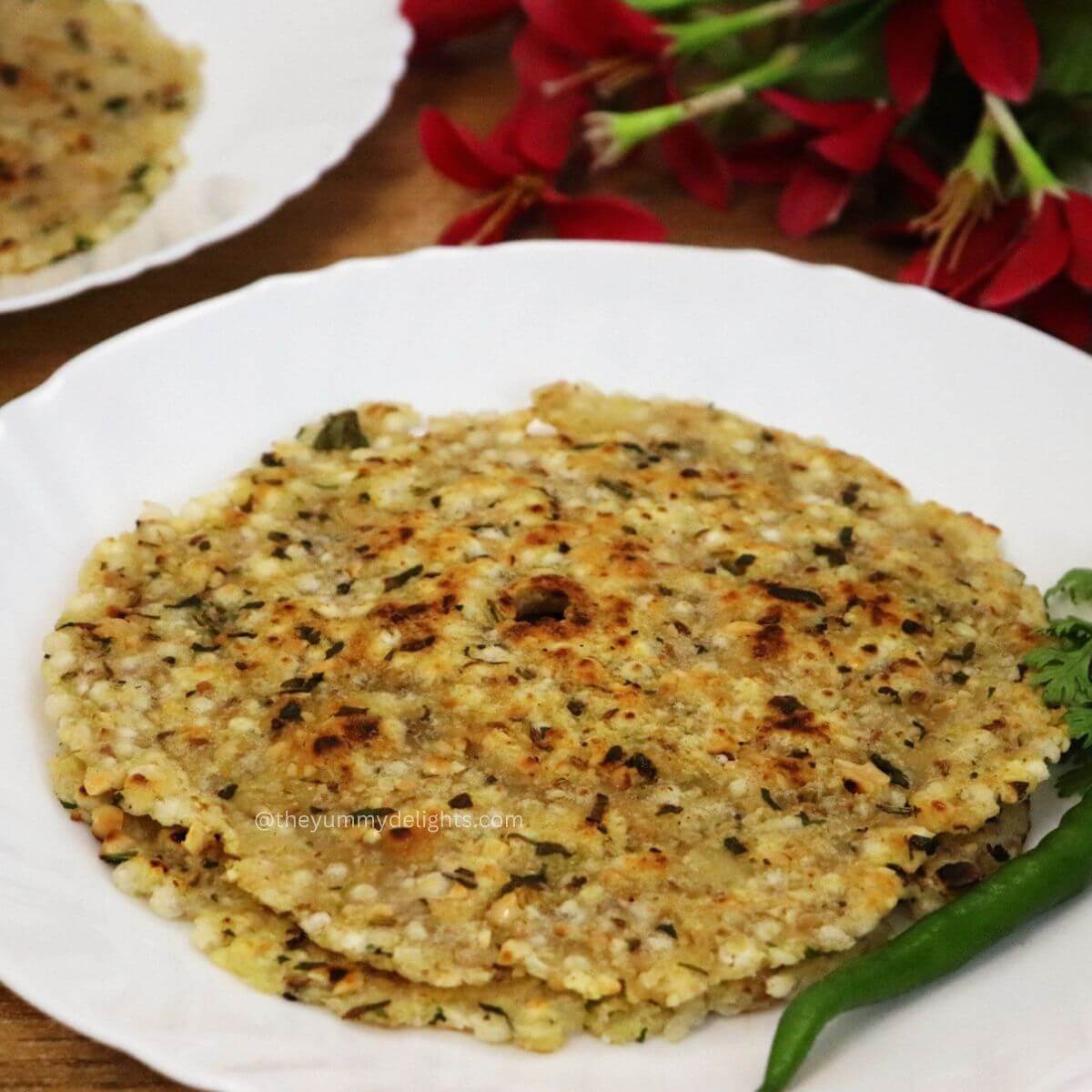
Sabudana Thalipeeth Recipe
Video

Equipment
- 1 Medium sized mixing bowl
- 1 skillet or frying pan
Ingredients
- 1 cup medium-sized sabudana tapioca pearls/sago
- ½ cup peanuts unsalted
- 1 big potato or 2 medium size cooked, peeled and grated. (¾ th cup)
- 2 green chilies finely chopped optional
- 1- inch ginger finely chopped
- 1 teaspoon cumin
- salt to taste or sendha namak for fasting
- ¼ cup finely chopped coriander leaves
- 1 teaspoon finely chopped curry leaves, optional
Instructions
- Soaking Sabudana: Rinse the sabudana two or three times until the water runs clear. Drain it, then add one cup of water. Cover and soak the sabudana overnight or 4-6 hours. By morning, all the water should be absorbed. Mash one sabudana to check if it gets mashed easily. Set the soaked sabudana aside.
- Roasting Peanuts: Dry-roast the peanuts in a pan over low to medium heat, stirring constantly until golden brown spots appear. Remove from the heat and let them cool to room temperature. Rub the peanuts between your palms to remove the skin. Coarsely grind the roasted peanuts using a chopper or a mortar and pestle. Tip: Do not grind them too coarsely. They should be finely ground, but not powdered. If there are large chunks of peanuts, it will be difficult to shape or fry the thalipeeth as it will break and not hold its shape.
- Making Sabudana Thalipeeth Dough: In a mixing bowl, add the soaked sabudana, potatoes, chopped peanuts, green chilies, ginger, cumin, salt, coriander leaves and curry leaves. Mix well while mashing them slightly until the mixture holds its shape. Tip: Apply oil on palms before you handle the dough mixture.
- Shaping the Thalipeeth: Lightly oil a piece of parchment paper or butter paper. Take a portion of the sabudana mixture, and place it on the parchment paper or butter paper. Wet your fingers with water and gently pat the mixture to spread it. To prevent the sides from tearing, hold them with your other hand while spreading. Shape the dough into a round disc, similar to a roti (Indian flatbread). Finally, make a small hole in the center. Watch the video for easy understanding.Tip: Using wet fingers prevents the dough from sticking while spreading and shaping thalipeeth.
- An easier way to shape thalipeeth is to use a plate. Place parchment paper on the plate, and spread the dough with wet fingers. This makes it much simpler to rotate and shape the thalipeeth, ensuring they are consistently sized.
- Cooking Sabudana Thalipeeth: Heat a tawa (griddle) over medium-low heat. Once the skillet is hot, place the thalipeeth onto it, with the parchment paper facing upwards. Reduce the heat to low-medium and cook for a minute. Gently peel off the parchment paper. Drizzle one teaspoon of oil over the top and center of the thalipeeth. Cook until golden brown spots appear. Meanwhile you can shape another thalipeeth. Flip and cook the other side until golden and crispy. Remove sabudana thalipeeth to a plate. Serve with chutney or yogurt.Tip: Cook it on low heat until golden brown spots appear, then flip it. Don't flip it too early, or it will break. Also never cook thalipeeth on high heat. Add more oil if needed.
Notes
- Soaking Sabudana: Make sure the soaked sabudana is soft and separate. If it feels hard, sprinkle some water over it and cover and keep it aside for 30 minutes to an hour.
- Binding: Make sure the potatoes are cooked perfectly. Boil potatoes until fork-tender but not mushy. Cool boiled potatoes before grating. Overcooked potatoes may make the thalipeeth mixture soggy and sticky. Also grate the cooked potatoes before adding them to the thalipeeth mixture.
- Cooking: Always cook on medium to low heat for even cooking and crispy edges. High heat will result in soft thalipeeth that are difficult to flip and break easily.
- Flipping carefully: Wait until the bottom side of the thalipeeth is golden brown before flipping to prevent the thalipeeth from breaking.
Nutrition
Nutrition information is automatically calculated, so should only be used as an approximation.





Preeti
Making the perfect sabudana thalipeeth has always been a little tricky, but I'm so excited to share my family's secret for one that's perfectly crisp and never soggy. I promise you'll love how light, filling, and deliciously crispy these thalipeeth turn out, so give them a try and let me know what you think.